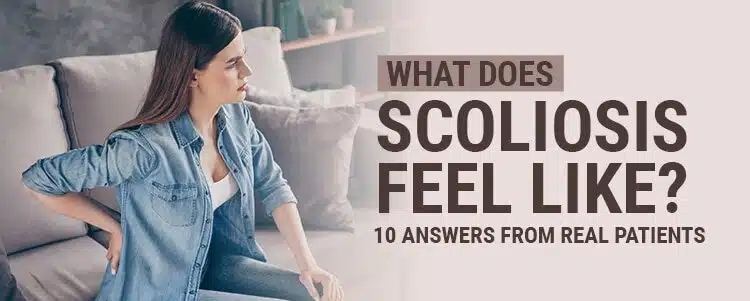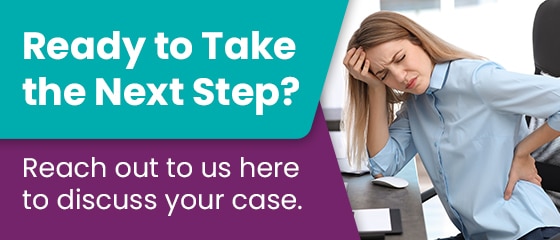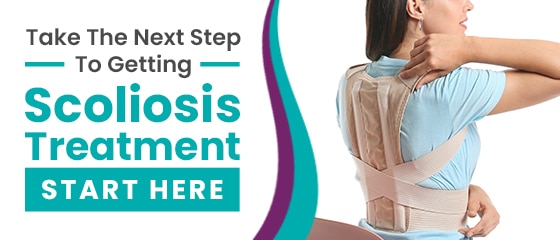Scoliosis can range in severity from mild to severe, so it can be difficult to get a consistent understanding of how it feels. We have talked to 10 different patients with one thing in common: they all have scoliosis. Let’s explore their answers and what is happening in their bodies to make them feel that way.
Before we get into the 10 answers from real patients on how scoliosis feels, let’s take a minute to first touch on the main condition characteristics that shape a patient’s experience with their condition.
Scoliosis Characteristics
As there isn’t one form and severity level of scoliosis, one patient’s description of how it feels to have scoliosis can differ greatly from the next. This is mainly because scoliosis, as a complex condition, can take many forms and develop across a wide spectrum.
Some of the condition’s main characteristics that shape a patient’s experience with it are degree of severity, cause (if known), location of curvature, and age.
Degree of Severity
When a person receives a scoliosis diagnosis, their condition is classified in a number of ways. Firstly, it’s placed on the condition’s severity scale based on the patient’s Cobb angle.
The Cobb angle is a measurement taken, via X-ray, that uses the most-tilted vertebrae at the apex of the curve to tell us how far out of alignment the spine is.
The higher the Cobb angle, the more severe the condition, and while no two experiences are the same, condition severity does indicate likely symptoms.
Causation
In the condition’s most common form, adolescent idiopathic scoliosis (AIS), there is no known single cause, and this group makes up 80 percent of known diagnosed scoliosis cases.
The other 20 percent have known causes such as neuromuscular, congenital, degenerative, and traumatic.
If a scoliosis patient has a curvature bending to the right, this is a typical case; if a patient has a curvature that bends to the left, towards the heart, this is considered atypical and is a red flag for me that the patient’s scoliosis could be a secondary complication of a more serious medical issue.
Cause, when known, helps determine treatment and also shapes how a patient will experience their condition based on the form it has taken.
Location of the Curvature
Scoliosis can develop anywhere along the spine’s three main sections: cervical, thoracic, and lumbar.
As you can imagine, where the curvature develops is not only important in terms of treatment, but also guides a patient’s experience of how their condition feels by developing symptoms characteristic of curvature location.
For example, thoracic scoliosis is the most common and is commonly accompanied by the development of a ‘rib arch’ as the spinal deformity pulls on the rib cage, altering its position.
Age of Patient
Age of patient is a significant factor, not only because it gives us an idea of the patient’s health and ability to handle treatment, but also because it affects the patient’s experience in terms of pain and progression.
The main trigger for progression is growth, so we know younger patients who have not yet reached skeletal maturity are facing a higher risk of progression; we know that adults who have reached skeletal maturity will still face progression, but likely at a much slower rate.
We also know that AIS is generally a painless condition because a spine that is constantly growing isn’t vulnerable to the compressive force of the curvature; that being said, many adolescents still experience related muscle pain and stiffness.
In adults, scoliosis can be very uncomfortable as the abnormal spinal curvature compresses the spine and its surrounding vessels, nerves, and muscles. This can result in back pain and radiating pain in the arms, legs, and feet.
Now that we have a basic understanding of how and why the condition can vary so much from one person to the next, let’s take a look at some personal descriptions of how it feels to live with scoliosis.
“What Does it Feel Like to Have Scoliosis?”
Rebecca P: “It feels like you are stiff on one side. One side is more curvy than the other, and your legs can feel uneven.”
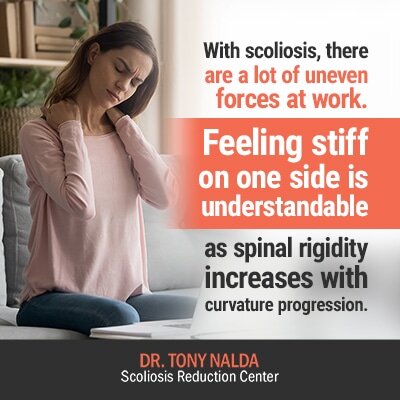
With scoliosis, there are a lot of uneven forces at work. Feeling stiff on one side is understandable as spinal rigidity increases with curvature progression.
The muscles surrounding the spine are also worked unevenly as they try to compensate for the uneven force of the abnormal spinal curvature and support the spine.
When an abnormal curvature is present, the body becomes asymmetrical as the spine’s biomechanics are thrown off, and this can give the appearance, and feeling, of the legs hanging at different lengths.
Baleg D: “It feels like you are being weighed down (pulled down). Your body feels loose, uncomfortable, and fragile.”
The feeling of being pulled down is understood as a result of the adverse tension that scoliosis introduces to the spine. A feeling of the body being pulled and stretched is a common description as the spine and the rest of the body faces the compressive nature of the abnormal curvature.
This can also affect balance and make patients feel like they can’t quite get comfortable in their own bodies.
Feeling fragile has a psychological component as patients can feel concerned about the spine’s ability to evenly absorb and distribute force. There is also the fear of trying new activities and not knowing how the spine will react.
Isabella V: “It feels like your shoulders are uneven and you are being pulled down to one side. Your back is painful.”
One of the early signs of scoliosis is an asymmetry to the shoulders. One can sit higher than the other, and one shoulder blade can protrude more prominently on one side than the other.
Again, the feeling of being pulled down and to one side is how it can feel as the body attempts to adjust to the uneven force of the scoliosis and the body’s shifting center of gravity.
As the spine runs through the body’s center, it makes sense that if it is out of alignment and bending to the side, the patient would feel that pull to the side.
While more common in the adult experience of scoliosis, the back becomes painful as the curvature progresses and makes the spine more rigid and less flexible. The compression of a curvature, especially in adults, can cause a lot of pain as it affects the vessels, nerves, and muscles that surround the spine.
Kate C: “For me, it feels like my hips are shifted and not aligned. I feel pain sometimes, but chiropractic adjustments have helped tremendously. I have also noticed some of the shoes I’m wearing sit uncomfortably on my right ankle due to the curve in my spine.”
An overall asymmetry to the body is a common symptom of scoliosis, and this includes the hips as one can sit higher than the other, or one side can appear more rounded/flatter than the other. This is especially characteristic of curvatures that develop in the thoracic and lumbar spine.
Scoliosis-specific chiropractic adjustments are a big component of my treatment approach here at the Scoliosis Reduction Center® as we attempt to restore as much of the spine’s healthy curves as possible, impacting the scoliosis on a structural level.
Scoliosis-specific chiropractic differs from traditional chiropractic in frequency/duration of treatment, and also in the actual form of chiropractic treatment. When using traditional chiropractic on a scoliosis patient the person with the condition is being treated, more so than the actual condition itself.
You can see how a spinal curvature, and its asymmetrical effects, can be felt throughout the body, as evident by Kate’s description of her ill-fitting shoes.
Tina N: “It feels like lower-left back pressure that gets relief when adjusted.”
Often patient’s descriptions of compression include feelings of pressure in the affected area. Scoliosis-specific chiropractic adjustments are used not only in an attempt to manipulate the spine to move in the direction we want it to, but also to keep the spine and its supporting muscles as loose as possible.
Spinal rigidity can become an issue in patients with scoliosis, especially as a curvature progresses. With functional treatment, the goal is to preserve as much as the spine’s natural flexibility as possible, and this also helps alleviate scoliosis-related back pain.
While it’s great that adjustments can help reduce pain and pressure in the lumbar spine, these results are more short-term; only a curvature reduction at a structural level can bring long-term changes such as more-permanent pain relief.
Brianna T: “Emotionally, it feels like a heavy weight; it makes me scared of what I look like. Physically, it feels like pressure on my rib cage and makes it hard to breathe while working.”
I’m glad Brianna mentioned the emotional weight of scoliosis, as it can be heavy, especially for adolescents.
Much of the focus around scoliosis is on how to manage its progression, but not a lot of discussion centers around its psychological impact.
The average adolescent doesn’t want to stand out; they want to blend in. They don’t want to look or walk differently from their peers, and living in this digital age of social media puts a lot of extra pressure on teens to have the perfect body to go along with their perfect lives.
I try to keep an open dialogue on how the condition is affecting my patients emotionally as I do feel it can be significant and needs to be addressed like any other symptom.
Curvatures, especially those along the thoracic spine, are known to pull on the rib cage and alter its positioning, causing the characteristic ‘rib arch’ – one of the telltale signs that scoliosis is present.
Sometimes, more so in extreme cases, a rib deformity can put pressure on the chest, leaving less room for the lungs to inhale/exhale deeply.
In most cases, scoliosis and an accompanying rib deformity have to be extreme to produce any noticeable changes to lung function. As Brianna indicates, most changes to lung function are noticed during times of exertion.
Ariel Y: “At first, it felt like nothing, but now it feels painful when doing certain activities. Emotionally, it feels scary, even if you feel no pain. Just knowing you have it and need to fix it is scary.”
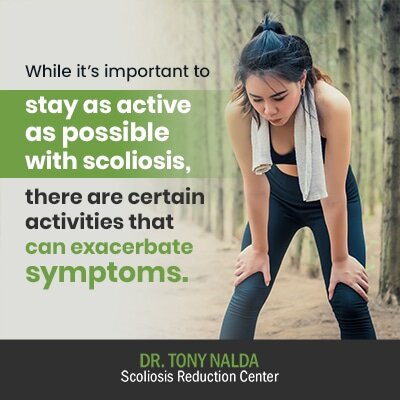
When Ariel was first diagnosed, the condition was mild, and as it progressed, it became more noticeable and painful.
While it’s important to stay as active as possible with scoliosis, there are certain activities, such as those that overwork one side of the body or include jarring motions, that can exacerbate symptoms: golf, tennis, football, etc.
It’s always wise to consult with your doctor to determine which exercises/activities are deemed harmful to scoliosis.
The emotional pressure, again, is reported as significant. This is why it’s so crucial to ensure that your loved one has a safe place to vent their scoliosis-related feelings and fears.
Aneka T: “I am sometimes limited with my activities on my left side such as dance and exercise.”
Depending on how severe a patient’s scoliosis is, certain activities can be affected. As mentioned in the last response, movements that overuse one side of the body can contribute to the uneven forces at work within the condition, so these are types of activities we want to limit in scoliosis patients.
When it comes to dance/exercise, scoliosis-specific exercise is an important part of our functional treatment approach, but again, any activity/exercise should first be cleared with your doctor and might need to be tweaked to find that ideal balance.
Jayme F: “It feels like a stiffness and tightness in my lower back.”
While more common in adults, stiffness and tightness of the lower back can be a common scoliosis-related symptom.
As the body tries to adjust to the abnormal spinal curvature, muscles and ligaments can become stretched and strained from overuse. As the uneven force of the curvature increases, the body tries to overcompensate in a number of ways to restore the spine’s biomechanics.
In adults, compression is often the culprit of multiple forms of scoliosis-related pain as the spine, its nerves and surrounding muscles are all affected.
Keith R: “It feels like a tightness in the lower back and a lack of flexibility.”
Again, the feeling of tightness and pressure is a common thread in these answers. Fortunately, active treatment has the power to impact the scoliosis on a structural level, reducing the curvature, and lessening related symptoms, such as pain and stiffness, along with it.
When it comes to a lack of flexibility, this is most common in large curvatures and adult scoliosis.
A loss of spinal flexibility is a natural degenerative effect of aging, and when paired with the presence of scoliosis, spinal rigidity can be a challenge when it comes to treatment.
In cases where the spine doesn’t have a lot of movement, it’s that much harder to get it to move where we want it to. Often, we need to do some work to restore mobility before we shift the focus to achieving a curvature reduction.
Conclusion
So what does scoliosis feel like? As you can see from our 10 answers given by real patients, the description is not always consistent.
From physical to emotional, scoliosis comes with a lot of variables that guide a patient’s experience of daily life with the condition.
While complaints of stiffness and pain are a common thread, some responses focus more heavily on the psychological effects of the condition.
What we can learn from these answers is how to better support our patients, and loved ones living with the condition, by maintaining an open dialogue that addresses all potential challenges of navigating life with scoliosis.
